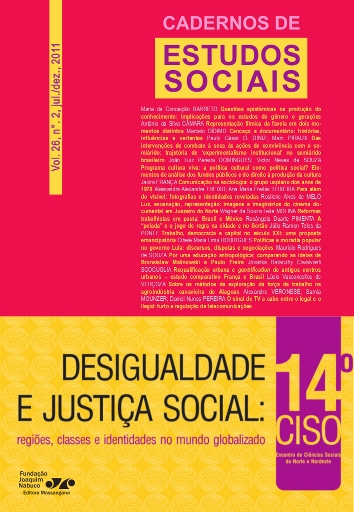Representação fílmica da favela em dois momentos distintos
Abstract
RESUMO Este texto analisa dois filmes que representam a pobreza urbana nas favelas do Rio de Janeiro. O primeiro, Cinco Vezes Favela, realizado em 1962, é um misto de documentário e cinema ficcional que apresenta cinco visões distintas da favela no Rio, mostrando a face pobre do Rio de Janeiro no momento em que se iniciava a brutal alteração demográfica do espaço urbano. O segundo, Santa Marta: duas semanas no morro, dirigido por Eduardo Coutinho em 1987, apresenta temáticas predominantemente urbanas como o tráfico e a violência policial; aparecem também a cultura tradicional e a religiosidade popular. Em ambos verifica-se a antecipação de problemas que darão origem a explosão da violência na vida urbana nos dias atuais: a ausência de oportunidades, a pobreza e a exclusão social. Palavras chave: Cinema; representações fílmicas; favela. ABSTRACT This paper analyzes two films that represent the urban poverty in the slums of Rio de Janeiro. The first: Cinco vezes Favela, held in 1962, is a mix of documentary and fictional film which presents five different views of the slums in Rio, showing the poor face of Rio de Janeiro in the moment that was beginning the brutal demography change in the urban space. The second film, Santa Marta: duas Semanas no Morro, directed by Eduardo Coutinho in 1987, presents themes that are predominantly urban, such as drugs traffic and police violence; also appear the traditional culture and popular religiosity. In both films we could see the anticipation of problems that will give rise to explosion of violence in urban life these days: the lack of opportunities, poverty and social exclusion. Key words: Cinema; filming representation; slums.Downloads
Downloads
Published
2012-03-29
How to Cite
Câmara, A. da S. (2012). Representação fílmica da favela em dois momentos distintos. Cadernos De Estudos Sociais, 26(2). Retrieved from https://fundaj.emnuvens.com.br/CAD/article/view/1455
Issue
Section
Artigos - número 2
License
Autores que publicam nesta revista concordam com os seguintes termos:
- Autores mantém e retém os direitos autorais. Os mesmos concedem à revista o direito de primeira publicação, com o trabalho simultaneamente licenciado sob a Licença Creative Commons Attribution que permite o compartilhamento do trabalho com reconhecimento da autoria e publicação inicial nesta revista.
- Autores têm autorização para assumir contratos adicionais separadamente, para distribuição não-exclusiva da versão do trabalho publicada nesta revista (ex.: publicar em repositório institucional ou como capítulo de livro), com reconhecimento de autoria e publicação inicial nesta revista.


